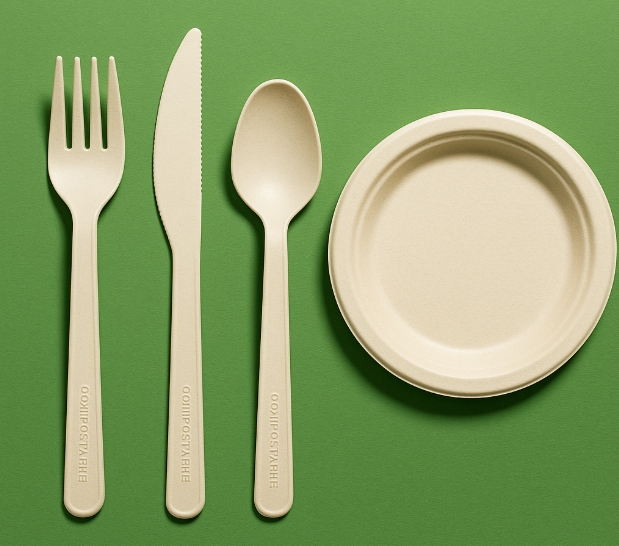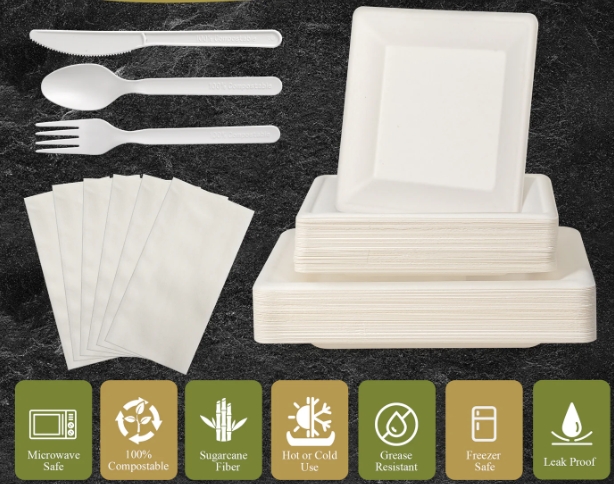
Content Menu
● Understanding Good Quality Disposable Plates and Cutlery
>> What Makes Disposable Plates and Cutlery "Good Quality"?
>> Common Materials Used
● The Recycling Reality for Disposable Plates and Cutlery
>> Paper-Based Plates and Cutlery
>> Plastic Plates and Cutlery
>> Bioplastics and Compostable Plastics
● Compostability of Good Quality Disposable Plates and Cutlery
>> What Does Compostable Mean?
>> Composting Natural Fiber Plates and Cutlery
>> Composting Bioplastics
● Challenges in Recycling and Composting
>> Contamination Issues
>> Lack of Facilities
>> Misleading Labels
● Making Environmentally Responsible Choices
>> Choosing the Right Products
>> Proper Disposal Practices
>> Considering Reusable Alternatives
● The Future of Disposable Plates and Cutlery
● Conclusion
● FAQ
>> 1. How do I know if my disposable plates and cutlery are compostable?
>> 2. Can plastic disposable plates and cutlery be recycled in regular recycling bins?
>> 3. What should I do if composting facilities are not available in my area?
>> 4. Are there good quality disposable plates and cutlery that are both recyclable and compostable?
>> 5. What are the best alternatives to disposable plates and cutlery for large events?
Disposable plates and cutlery have become a staple in modern life, especially for gatherings, picnics, and parties. The convenience they offer is undeniable, but their environmental impact has become a growing concern. As more people seek sustainable solutions, the question arises: Can good quality disposable plates and cutlery be recycled or compostable? This comprehensive exploration will guide you through the materials, recycling and composting realities, and best practices for making eco-friendly choices.

Understanding Good Quality Disposable Plates and Cutlery
What Makes Disposable Plates and Cutlery "Good Quality"?
The term "good quality" refers to disposable plates and cutlery that are sturdy, reliable, and capable of handling a variety of foods without breaking or leaking. These products are often designed to mimic the feel and function of traditional dinnerware, offering guests a pleasant dining experience. Good quality disposable plates and cutlery are typically made from materials that are thicker, more durable, and sometimes even aesthetically pleasing compared to their flimsy counterparts.
Common Materials Used
Good quality disposable plates and cutlery are made from a range of materials, including:
- Paperboard: Sometimes coated for extra strength and resistance to moisture.
- Plastic: Includes types like polypropylene, polystyrene, and sometimes more advanced plastics.
- Bioplastics: Made from renewable plant sources such as corn or sugarcane.
- Bamboo: Known for its strength and renewable nature.
- Palm Leaf and Sugarcane Bagasse: Natural materials that are molded into sturdy shapes.
Each material has its own environmental pros and cons, which greatly influence whether the item can be recycled or composted.
The Recycling Reality for Disposable Plates and Cutlery
Paper-Based Plates and Cutlery
Paper-based options are popular for their perceived eco-friendliness. However, many good quality disposable plates and cutlery made from paper are coated with a thin layer of plastic or wax. This coating is meant to prevent sogginess and leaks, but it poses a challenge for recycling. Most recycling facilities are not equipped to separate the coating from the paper, which means these items often end up in landfills.
If the plates and cutlery are uncoated and free from food residue, some recycling programs may accept them. However, the majority of paper-based disposables, especially those with coatings, are not suitable for recycling due to contamination and material complexity.
Plastic Plates and Cutlery
Plastic disposable plates and cutlery are valued for their strength and versatility. The most common plastics used are polypropylene and polystyrene. While some of these plastics are technically recyclable, many local recycling programs do not accept them because they are small, lightweight, and easily lost in the sorting process. Additionally, food contamination further complicates recycling efforts.
Even when good quality disposable plates and cutlery are made from recyclable plastic, the reality is that they are rarely recycled. The best-case scenario is that they are sent to specialized facilities, but most end up in landfills or incinerators.
Bioplastics and Compostable Plastics
Bioplastics are a newer innovation in the world of disposables. These materials are derived from plants and are often labeled as compostable or biodegradable. However, not all bioplastics are created equal. Some require industrial composting facilities to break down properly, while others may not decompose fully in home composting systems.
Recycling bioplastics is not straightforward either. They cannot be processed with traditional plastics and may contaminate recycling streams if mixed in. Therefore, unless you have access to an industrial composting facility, bioplastic plates and cutlery may not be as eco-friendly as they appear.
Compostability of Good Quality Disposable Plates and Cutlery
What Does Compostable Mean?
A compostable product is one that can break down into natural elements in a compost environment, leaving no toxic residue. Compostable plates and cutlery are usually made from materials like bamboo, palm leaves, sugarcane bagasse, or certified compostable bioplastics.
Composting Natural Fiber Plates and Cutlery
Good quality disposable plates and cutlery made from bamboo, palm leaves, or sugarcane are excellent candidates for composting. These materials are derived from renewable resources and, when free of coatings or additives, can break down in both home and industrial composting systems.
The key to successful composting is ensuring that the plates and cutlery are clean and do not contain synthetic coatings or inks. When composted properly, these items return nutrients to the soil and help close the loop in the lifecycle of the product.
Composting Bioplastics
Some good quality disposable plates and cutlery are made from compostable bioplastics. However, most of these products are only compostable in industrial facilities that provide the high heat and controlled conditions necessary for decomposition. Home composting systems may not reach the temperatures required to break down these materials fully.
If you have access to an industrial composting facility, compostable bioplastics can be a sustainable choice. Otherwise, they may persist in the environment or end up in landfill.

Challenges in Recycling and Composting
Contamination Issues
One of the biggest challenges in recycling or composting good quality disposable plates and cutlery is contamination. Food residue, grease, and sauces can render even recyclable or compostable items unsuitable for processing. Always ensure that disposables are as clean as possible before placing them in recycling or compost bins.
Lack of Facilities
Not all communities have access to industrial composting or advanced recycling facilities. Even if your disposable plates and cutlery are technically compostable or recyclable, they may end up in landfill if local infrastructure cannot handle them.
Misleading Labels
Some products are labeled as biodegradable or compostable, but without certifications, these claims can be misleading. Look for products with recognized certifications to ensure they meet compostability or recyclability standards.
Making Environmentally Responsible Choices
Choosing the Right Products
When selecting good quality disposable plates and cutlery, consider the following:
- Material: Opt for uncoated paper, bamboo, palm leaf, or certified compostable bioplastics.
- Certifications: Look for compostable certifications from reputable organizations.
- Local Facilities: Check whether your community has the infrastructure to recycle or compost the products you choose.
Proper Disposal Practices
To maximize the environmental benefits of good quality disposable plates and cutlery:
- Clean Before Disposal: Remove as much food residue as possible.
- Sort Correctly: Place items in the correct recycling or composting bins.
- Educate Others: If hosting an event, provide clear instructions for guests on how to dispose of their plates and cutlery.
Considering Reusable Alternatives
While good quality disposable plates and cutlery offer convenience, reusable options are the most sustainable. For smaller gatherings or events where washing is feasible, consider using traditional dinnerware or high-quality reusables made from stainless steel, glass, or durable plastic.
The Future of Disposable Plates and Cutlery
The demand for sustainable disposables is driving innovation in materials and design. Manufacturers are developing new products that balance quality, functionality, and environmental responsibility. As recycling and composting infrastructure improves, the options for responsibly disposing of good quality disposable plates and cutlery will expand.
Consumers play a crucial role by making informed choices, supporting sustainable brands, and advocating for better waste management systems. By understanding the realities of recycling and composting, we can all contribute to a cleaner, greener future.
Conclusion
Good quality disposable plates and cutlery can be recycled or composted, but the answer depends on the material and local waste management capabilities. Paper and plastic items face significant recycling challenges, especially when coated or contaminated with food. Compostable options made from bamboo, palm leaf, or sugarcane offer a more sustainable solution, provided composting facilities are available. The key to making an environmentally positive impact lies in choosing the right products, following proper disposal practices, and supporting improvements in recycling and composting infrastructure. By taking these steps, we can enjoy the convenience of disposables without sacrificing our commitment to the planet.

FAQ
1. How do I know if my disposable plates and cutlery are compostable?
Check for certification labels from reputable organizations on the packaging. Compostable products are usually made from materials like bamboo, palm leaf, or sugarcane and do not have synthetic coatings or dyes.
2. Can plastic disposable plates and cutlery be recycled in regular recycling bins?
Most plastic disposable plates and cutlery are not accepted in regular recycling bins due to their size, shape, and potential contamination. Always check with your local recycling program for specific guidelines.
3. What should I do if composting facilities are not available in my area?
If composting facilities are not available, dispose of compostable plates and cutlery in the trash. While they will eventually break down, the process is much slower in landfill conditions. Consider advocating for better composting infrastructure in your community.
4. Are there good quality disposable plates and cutlery that are both recyclable and compostable?
Some products are designed to be both recyclable and compostable, but this is rare. Most items are optimized for one disposal method. Always read the packaging and follow local disposal guidelines.
5. What are the best alternatives to disposable plates and cutlery for large events?
Reusable plates and cutlery made from stainless steel, glass, or durable plastic are the best alternatives. For large events where disposables are necessary, choose certified compostable options and provide clear instructions for proper disposal.

















